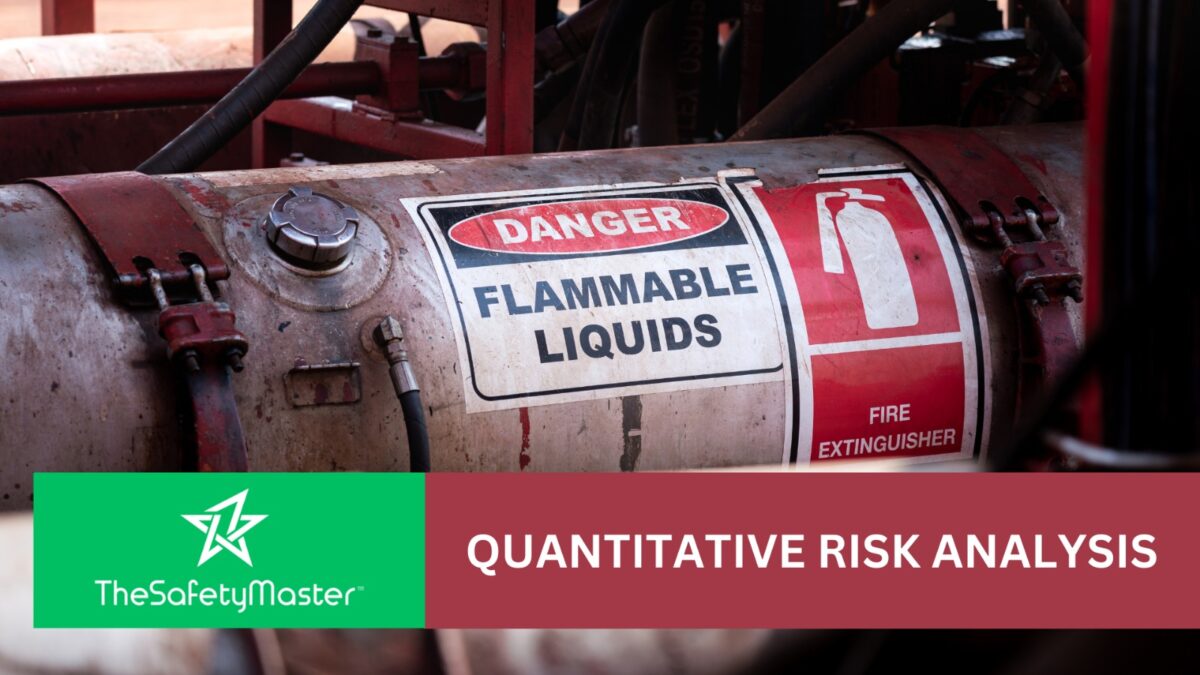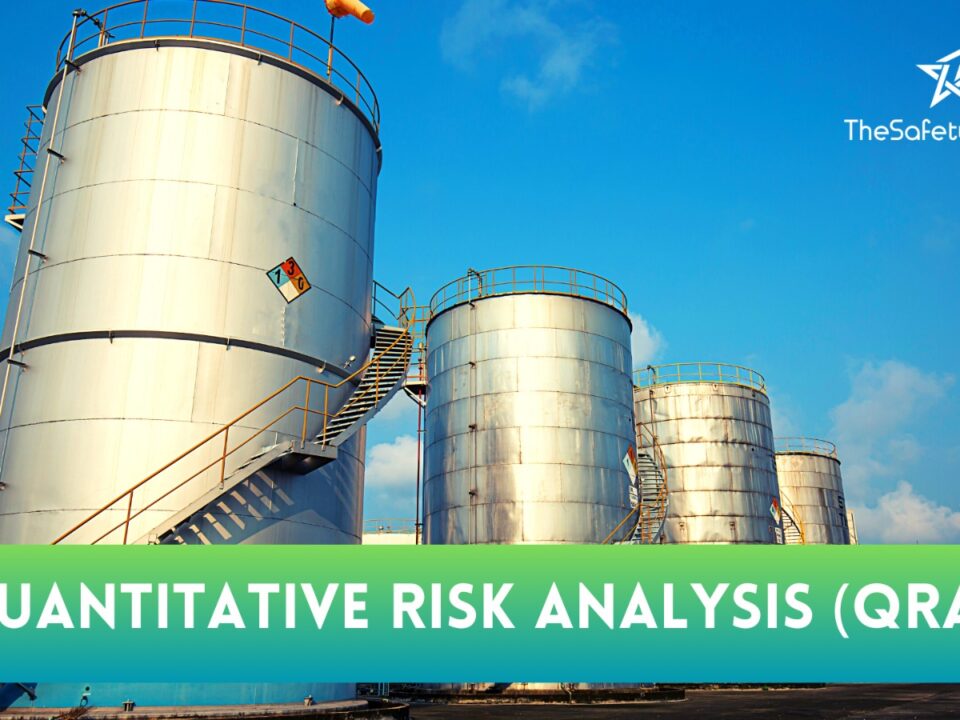Overcoming Challenges: How Quantitative Risk Assessment Improves Risk Management Practices in Indian Process Plants

The Power of Behavior-Based Safety (BBS) Implementation for Achieving a Transformational Safety Culture in the Workplace
October 21, 2023
A Closer Look at the Indian Standard Requirements for Electrical Safety Audits: Key Considerations for Safe Operation of Businesses
October 23, 2023In this article, we delve into the realm of risk management practices in Indian process plants, uncovering the challenges faced by industry professionals. Emphasizing the need for a solution that brings tangible results, we explore how quantitative risk assessment can revolutionize risk management. By honing in on the problem at hand, we set the stage for an enlightening journey where readers can expect to gain profound insights into the power of data-driven decision-making. Join us as we promise to unveil a game-changing approach that enhances safety, efficiency, and overall plant performance. With the power of quantitative risk assessment, the path to overcoming challenges begins.
Introduction
Imagine the intricate web of processes, infrastructure, and personnel that make up a process plant in India. These plants, crucial for the country’s industrial growth, face numerous challenges in ensuring the safety and reliability of their operations. One such prominent challenge is effective risk management, which plays a vital role in protecting not only the plant but also the surrounding environment and communities. In this article, we delve into the world of risk management practices in Indian process plants and explore how quantitative risk assessment can be a game-changer. We will navigate through the complexities of this subject matter to shed light on its significance and offer actionable insights for overcoming challenges along the way
Understanding the Importance of Risk Management in Indian Process Plants
Amidst the bustling landscape of Indian process plants, risk management stands as a paramount concern. These plants, which play a pivotal role in various industries such as chemicals, oil and gas, and power generation, are prone to a multitude of risks that can have far-reaching consequences. Risk management in Indian process plants entails identifying potential hazards and implementing strategies to mitigate them effectively. It is an intricate task that demands unwavering attention to detail and comprehensive understanding. The importance of risk management in Indian process plants cannot be overstated. These facilities handle hazardous materials, complex machinery, and intricate processes on a daily basis. With such intricacy comes inherent risks that can jeopardize the safety of not only the workers but also the surrounding environment and communities. By prioritizing risk management practices, Indian process plants demonstrate their commitment to safeguarding lives and preserving the ecological balance.
However, comprehending the significance of risk management is just the first step on a challenging journey. Indian process plants face numerous obstacles when it comes to implementing effective risk management practices. Limited resources, outdated methodologies, lack of expertise, and cultural barriers pose significant challenges that must be addressed with strategic precision. Despite these hurdles, it is essential for industry leaders to recognize that overcoming challenges leads to exponential growth and enhanced safety measures within their operations
The Challenges Faced in Risk Management Practices
The Challenges Faced in Risk Management Practices: Navigating the treacherous waters of risk management in Indian process plants is akin to treading on a tightrope suspended high above a raging storm. One of the biggest challenges lies in the sheer complexity of these plants, where numerous interconnected processes create a web of potential risks. Identifying, assessing, and mitigating these risks is a Herculean task that demands meticulous attention to detail and unwavering vigilance.
Adding fuel to the fire are the constantly evolving regulatory requirements and industry standards that demand compliance. Staying up-to-date with these ever-changing guidelines can feel like chasing a mirage in the scorching desert. Furthermore, resource constraints pose yet another hurdle for risk management practitioners, as limited budgets and manpower make it difficult to allocate adequate resources for comprehensive risk assessments.
In this challenging landscape, communication gaps between various stakeholders exacerbate the problem. Effective coordination among plant operators, risk assessment experts, and management personnel is crucial for successful risk mitigation strategies. Overcoming these obstacles requires not just technical expertise but also strong leadership skills and a holistic approach that fosters collaboration and knowledge sharing. By acknowledging these challenges head-on and embracing innovative solutions like quantitative risk assessment techniques, Indian process plants can pave their way towards safer operations with confidence
The Need for Quantitative Risk Assessment in Indian Process Plants
Quantitative risk assessment (QRA) emerges as an indispensable tool in the realm of risk management for Indian process plants, catapulting their safety and reliability to new heights. By quantifying and analyzing potential risks, QRA provides a comprehensive understanding of the likelihood and consequences of various hazards. This enables organizations to make informed decisions regarding risk mitigation strategies, resource allocation, and emergency preparedness. In the context of Indian process plants, where safety standards are of paramount importance due to the potential impact on human lives and the environment, QRA proves invaluable. It allows stakeholders to assess risks based on scientific principles rather than relying solely on subjective assessments. Through detailed calculations and simulations, QRA considers factors such as chemical reactions, equipment failures, human error probabilities, weather conditions, and consequence modelling.
Implementing QRA in Indian process plants not only enhances safety but also promotes a culture of proactive risk management. By identifying vulnerabilities and highlighting areas that require attention or improvement, QRA empowers organizations to prioritize resources effectively. This leads to optimized risk reduction strategies and increased operational resilience – a crucial aspect considering India’s rapid industrial growth.
In summary, the need for quantitative risk assessment in Indian process plants cannot be overstated. By utilizing this powerful tool, organizations can proactively identify potential risks, implement targeted mitigation measures that align with their resources effectively while fostering a culture that values safety above all else. Embracing QRA sets a positive trajectory toward enhanced operational excellence – one where challenges are confronted head-on with unwavering determination.
Key Components of Quantitative Risk Assessment in Risk Management
Quantitative risk assessment (QRA) is an indispensable tool for effective risk management in Indian process plants. It involves a comprehensive analysis of various components to provide a quantitative understanding of potential risks and their potential impact. Four key components are integral to the QRA process: hazard identification, consequence analysis, probability assessment, and risk estimation. Hazard identification is the initial step in QRA, where all possible hazards and their associated sources are identified within the process plant. This includes considering both internal hazards (such as equipment failures or human errors) and external hazards (such as natural disasters or terrorist attacks). Ensuring a thorough identification of hazards lays the foundation for accurate risk assessment.
Consequence analysis evaluates the potential consequences that may result from identified hazards. This involves assessing various scenarios and determining potential impacts on personnel safety, environmental damage, property loss, and business continuity. Detailed analysis helps in quantifying the severity of consequences for different events to prioritize risk mitigation efforts effectively.
Probability assessment focuses on estimating the likelihood or frequency of specific hazardous events occurring within the process plant environment. It involves analyzing historical data, statistical models, expert opinions, and industry-specific research to assign probabilities to each identified hazard event. Precise probability estimation assists in prioritizing risks based on their likelihood of occurrence.
Risk estimation combines information from hazard identification, consequence analysis, and probability assessment to determine an overall measure of risk associated with each hazard event. It often involves using quantitative techniques such as fault tree analysis or event tree analysis to assess dependencies between multiple events and calculate the level of risk represented by each scenario
Case Studies: Real-Life Examples of How Quantitative Risk Assessment has Improved Risk Management
Case Studies: Real-Life Examples of How Quantitative Risk Assessment Has Improved Risk Management in the bustling city of Mumbai, a chemical processing plant faced mounting safety concerns due to a complex network of hazardous substances and intricate operations. By implementing quantitative risk assessment techniques, the plant was able to identify critical areas prone to accidents and evaluate potential consequences. Through extensive analysis, they discovered that by modifying certain operational procedures and investing in additional safety measures, the risk of catastrophic incidents could be significantly reduced. The successful implementation of quantitative risk assessment not only enhanced safety protocols but also instilled confidence among employees, fostering a culture of proactive risk management.
Moving northwards to Gujarat, an oil refinery encountered challenges in maintaining stability amidst volatile market conditions. With quantitative risk assessment as their guiding light, they meticulously evaluated various parameters such as economic factors, geopolitical risks, and market fluctuations that could impact their operations. This comprehensive approach enabled them to make informed decisions regarding procurement strategies and investment planning. Consequently, they achieved remarkable cost savings by strategically managing risks associated with fluctuating oil prices while ensuring uninterrupted production. By embracing quantitative risk assessment methodologies, this refinery not only safeguarded its financial well-being but also strengthened its resilience against uncertainties.
Finally, venturing into the heartland of India lies a power generation plant in Madhya Pradesh that harnessed the power of quantitative risk assessment to tackle reliability issues head-on. With aging infrastructure causing frequent breakdowns and costly downtime, they sought a systematic solution to optimize asset performance and minimize operational disruptions. Employing sophisticated risk analysis tools allowed them to identify vulnerable components within their machinery and develop targeted maintenance strategies accordingly
Benefits of Implementing Quantitative Risk Assessment in Indian Process Plants
Benefits of Implementing Quantitative Risk Assessment in Indian Process Plants: Implementing quantitative risk assessment in Indian process plants offers a plethora of benefits that can greatly enhance risk management practices. Firstly, it provides a systematic and scientific approach to identify, analyze, and evaluate potential risks. By quantifying risks using sophisticated tools and methodologies, plant operators gain a comprehensive understanding of the likelihood and consequences of various hazards.
Secondly, quantitative risk assessment facilitates informed decision-making by providing reliable data and insights. It enables plant managers to prioritize risks based on their severity and allocate resources accordingly. This proactive approach allows for effective risk mitigation strategies to be implemented, reducing the likelihood of accidents or incidents that could have detrimental effects on both personnel and the environment.
Furthermore, implementing quantitative risk assessment fosters a culture of continuous improvement within Indian process plants. It encourages regular monitoring and reassessment of risks, enabling organizations to adapt their risk management strategies as new information becomes available. This dynamic approach ensures that potential threats are constantly evaluated and mitigated with evolving best practices.
By embracing quantitative risk assessment in their operations, Indian process plants can not only enhance safety standards but also optimize resource allocation while achieving regulatory compliance. This proactive mindset ultimately fosters a sense of trust among stakeholders, reassuring them that every effort is being made to ensure operational excellence with minimal risks involved.
Overcoming Obstacles in Implementing Quantitative Risk Assessment
Overcoming Obstacles in Implementing Quantitative Risk Assessment Navigating through the implementation of quantitative risk assessment in Indian process plants can be a daunting task. One significant obstacle is the resistance to change. Many organizations are comfortable with conventional risk management methods and are hesitant to adopt new approaches. However, by emphasizing the benefits and potential improvements in safety and reliability, stakeholders can be convinced that embracing quantitative risk assessment is a step towards progress.
Another challenge lies in acquiring the necessary expertise. Implementing quantitative risk assessment requires specialized knowledge and skills, which may not be readily available within the organization. However, by investing in training programs and collaborating with external experts, companies can develop an internal workforce capable of effectively implementing this approach. This not only addresses the skill gap but also fosters a culture of continuous learning and improvement.
Furthermore, financial constraints often pose a hindrance to implementing quantitative risk assessment comprehensively. Conducting detailed assessments requires investment in technology, software tools, data collection systems, and infrastructure upgrades. While it may seem costly initially, organizations must recognize that these investments pay off in terms of improved safety measures, reduced incidents, and ultimately cost savings due to mitigated risks.
In overcoming these obstacles, organizations must remain determined and forward-thinking. By acknowledging that change is inevitable for progress and ensuring access to specialized knowledge while considering long-term benefits over short-term costs, Indian process plants can successfully implement quantitative risk assessment methodologies that revolutionize their risk management practices for a safer tomorrow.
Best Practices for Successful Implementation of Quantitative Risk Assessment
Best Practices for Successful Implementation of Quantitative Risk Assessment: To ensure a successful implementation of quantitative risk assessment in Indian process plants, it is crucial to follow a set of best practices. Firstly, establishing clear objectives and goals is paramount. By defining specific targets, such as reducing the probability of accidents or minimizing potential losses, organizations can align their efforts towards achieving these aims. This clarity sets the foundation for an effective risk management strategy.
Secondly, engaging with all stakeholders is vital for successful implementation. This includes collaboration between plant operators, risk management experts, and regulatory bodies to exchange knowledge and expertise. Open communication channels foster a collective understanding of risks and enable the development of comprehensive risk mitigation plans.
Furthermore, investing in advanced technology and tools plays a pivotal role in enhancing the accuracy and efficiency of quantitative risk assessment. Employing state-of-the-art software and sophisticated models allows for more precise predictions and better decision-making processes. Embracing technological advancements not only ensures improved risk management practices but also demonstrates an organization’s commitment to staying at the forefront of industry standards.
By adopting these best practices, Indian process plants can pave their way towards a safer operational environment while simultaneously enhancing their overall productivity and public image. Implementing quantitative risk assessment not only provides tangible benefits but also instills confidence among stakeholders that proactive measures are taken to mitigate risks effectively.
Impact of Quantitative Risk Assessment on Safety and Reliability of Indian Process Plants
The impact of quantitative risk assessment on the safety and reliability of Indian process plants is nothing short of transformative. By utilizing sophisticated mathematical models and statistical analysis, companies are now able to identify and prioritize potential risks with greater precision than ever before. This enables them to allocate resources effectively, implement targeted mitigation measures, and ultimately enhance the overall safety and reliability of their operations. Moreover, quantitative risk assessment provides a deeper understanding of the potential consequences associated with various hazards, allowing organizations to make informed decisions regarding risk tolerance levels. By quantifying risks in terms of probabilities and expected losses, companies can optimize their risk management strategies to strike a balance between operational efficiency and safety.
The implementation of quantitative risk assessment not only minimizes the likelihood of accidents but also creates a culture of continuous improvement within Indian process plants. It fosters proactive monitoring and evaluation systems that enable organizations to learn from near-misses or incidents, identify patterns or trends in risk exposure, and make necessary adjustments accordingly. This emphasis on ongoing learning leads to enhanced proficiency in hazard identification, response planning, and effective utilization of resources – ultimately contributing to safer work environments for employees while bolstering public trust.
In summary, integrating quantitative risk assessment into the framework of Indian process plants brings about unparalleled benefits in terms of safety enhancement, improved decision-making processes rooted in data-driven insights, as well as fostering a culture centered around continuous improvement. Through this approach that combines scientific rigor with practical application, organizations can confidently navigate challenges while ensuring that their operations remain secure and reliable.
Integration of Quantitative Risk Assessment into Overall Risk Management Framework
Integration of Quantitative Risk Assessment into Overall Risk Management Framework: Within the realm of risk management in Indian process plants, the incorporation of quantitative risk assessment (QRA) into the overall risk management framework is a pivotal step towards achieving optimal safety and reliability. By seamlessly integrating QRA into existing risk management practices, organizations can gain a comprehensive understanding of potential risks and devise effective strategies to mitigate them.
QRA serves as a robust tool that enables an organization to quantify risks associated with various activities, processes, and systems within their operations. This integration allows for a systematic evaluation and comparison of risks across different areas, facilitating informed decision-making at both strategic and operational levels. Moreover, by incorporating QRA into the overall risk management framework, Indian process plants are empowered to prioritize resources effectively, ensuring that mitigation efforts are focused on areas with the highest potential impact.
By integrating QRA into the larger risk management framework, organizations can foster a proactive approach towards managing risks rather than merely reacting to incidents. This integration enables continuous monitoring and improvement of safety measures while promoting a culture that values risk awareness and prevention. Ultimately, this holistic approach enhances the overall resilience and long-term sustainability of Indian process plants by creating an environment where employees feel empowered to identify potential hazards and work collaboratively towards mitigating them.
In conclusion, integrating quantitative risk assessment into the overall risk management framework is crucial for Indian process plants seeking to overcome challenges related to safety and reliability. By adopting this approach, organizations can proactively identify potential risks across their operations while prioritizing resources effectively. The integration also nurtures a culture that emphasizes continuous improvement in safety measures. Through such integration efforts, Indian process plants can pave their way towards success with confidence in their ability to overcome challenges while ensuring optimal productivity and employee well-being.
Conclusion
In conclusion, the implementation of quantitative risk assessment in Indian process plants has proven to be a game-changer in improving risk management practices. By adopting this approach, organizations are better equipped to identify and mitigate potential hazards, ensuring the safety and reliability of their operations. With the ability to accurately measure risks and allocate resources effectively, process plants are now able to make more informed decisions that not only protect their assets but also enhance overall productivity. As we move forward into a future where technology continues to advance, embracing quantitative risk assessment will undoubtedly pave the way for a safer and more secure industrial landscape.




